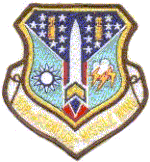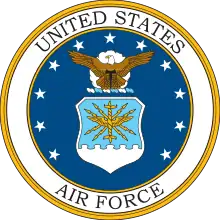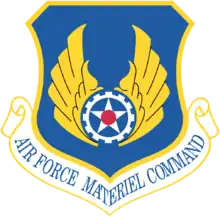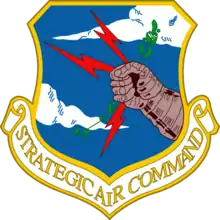308th Armament Systems Wing
The 308th Armament Systems Wing (308 ARSW) is an inactive United States Air Force unit. It was last assigned to the Air Armament Center, stationed at Eglin AFB, Florida. It was inactivated on 30 July 2010.
| 308th Armament Systems Wing | |
|---|---|
 Dr. Bruce Simpson, Air Armament Center Deputy for Acquisition, helps Randy Brown, 308th Armament Systems Wing Director, roll up the guidon for the former 308th Wing, 30 July 2010, at Eglin Air Force Base, Florida. | |
| Active | 1951–1961, 1962–1987, 2006–2010 |
| Country | |
| Branch | |
| Role | Armament Test and Evaluation |
| Garrison/HQ | Eglin AFB, Florida |
| Engagements | World War II Cold War |
| Decorations | Distinguished Unit Citation Air Force Outstanding Unit Award |
| Insignia | |
| 308th Armament Systems Wing emblem (Approved 22 August 2006[1] |  |
History
- For additional lineage and history, see 308th Armament Systems Group
Strategic Bombardment
In 1951, the 308th was activated as a bombardment unit at Hunter Air Force Base, Savannah Ga, and initially equipped with B-29s. Those aircraft were then replaced with new B-47E Stratojet swept-wing medium jet bombers in 1954, capable of flying at high subsonic speeds and primarily designed for penetrating the airspace of the Soviet Union. Also received KC-97 tankers. Over the next eight years, tie 308th conducted strategic bombardment training and air refueling to meet SAC's global commitments.
Deployed to bases in North Africa three times, twice in detachment form and once as a unit Sidi Slimane Air Base Morocco, 21 August – 26 October 1956). From November 1956 to March 1957, the wing tested the SAC alert plan by maintaining one-third of its bomber and tanker force on continuous alert.
The wing was broken up in mid July 1959, for unclear reasons. Part of the unit went to the 2nd Bomb Wing at Hunter AFB, Georgia. The bulk of the wing moved to Plattsburgh AFB, New York on 15 July 1959, where its aircraft were placed under the control of the 380th Bomb Wing. The wing was not operational as one formation from July 1959 to June 1961.
Intercontinental Ballistic Missiles
The Wing was redesignated and activated on 20 November 1961 as the 308th Strategic Missile Wing. In early 1962 the Air Force established 18 Titan II launch sites at SAC's Little Rock Air Force Base, Arkansas. The 308th was reactivated, being organized on 1 April 1962. The wing became fully operational with eighteen sites in December 1963. It gained control over its first missile complex in August 1962 and became fully operational with 18 sites in December 1963. In October 1981, US President Ronald Reagan announced that all Titan II sites would be deactivated by 1 October 1987, as part of a strategic modernization program. The wing completed deactivation on 18 August 1987.
308th Armament Systems Wing
On 23 November 2004 the Air to Ground Munitions Systems Wing was established at Eglin AFB, FL. It was tasked to design, develop, field and maintain a family of air-to-ground munitions that enhanced United States armed forces strike capabilities. The wing was activated on 27 January 2005. On 3 May 2006 the AGMS Wing was consolidated with the 308th Wing, and the resulting formation was redesignated the 308 Armament Systems Wing on 15 May 2006.
The wing was activated in 2004 to design, develop, field and maintain a family of air-to-ground munitions that enhance warfighter strike capabilities.
The mission of the 308th Armament Systems Wing was to enhance worldwide Air Force combat capability, effectiveness, aircrew survivability, and readiness through joint development, procurement, deployment and sustainment. This mission is executed by air combat test and training systems, expeditionary support equipment, munitions handling equipment and armament subsystems, Explosive Ordnance Disposal support equipment, and realistic Electronic Warfare threat simulators.
The 308 ARSW designed, develops, produces, fields, and sustains a family of air-to-ground and air-to-air munitions, enhancing warfighter capabilities (both U.S. and allies) in defeating a spectrum of enemy targets.
The 308 ARSW is a critical component of the Air Armament Center, which covers the complete weapon-system life-cycle from concept through development, acquisition, experimental testing, procurement, operational testing and final employment in combat.
The wing consists of over 400 highly qualified personnel trained in the development, test, acquisition, fielding, and operational support of systems such as the Joint Direct Attack Munition (JDAM), Joint Air-to-Surface Standoff Missile (JASSM), Small Diameter Bomb (SDB), Sensor Fuzed Weapon (SFW), Wind Corrected Munitions Dispenser (WCMD) and a host of other specialized programs.
The wing was inactivated on 30 June 2010 and became a directorate to comply with Air Force 2008–2010 Strategic Plan and the CSAF's directive to implement guidelines for new personnel strength standards for units across the Air Force.
Lineage
.gif)

- Established as the 308th Bombardment Wing, Medium on 4 October 1951
- Activated on 10 October 1951
- Inactivated 25 June 1961
- Redesignated 308th Strategic Missile Wing (ICBM-Titan), and activated, on 29 November 1961
- Organized on 1 April 1962
- Inactivated 18 August 1987
- Consolidated with the Air to Ground Munitions Systems Wing as the Air to Ground Munitions Systems Wing on 3 May 2006[1]
- Established as Air to Ground Munitions Systems Wing on 23 November 2004
- Activated on 27 January 2005
- Consolidated with the 308th Strategic Missile Wing on 3 May 2006
- Redesignated: 308th Armament Systems Wing on 15 May 2006[1]
- Inactivated on 30 June 2010
Assignments
- 38th Air Division, 10 October 1951
- Attached to 21st Air Division, 10 October 1951 – 17 April 1952
- Attached to 5th Air Division, 21 August-c. 26 October 1956
- 820th Air Division, 15 July 1959 – 25 June 1961
- Strategic Air Command, 29 November 1961
- 825th Air (later, 825th Strategic Aerospace) Division, 1 April 1962
- 42d Air Division, 1 January 1970
- 17th Strategic Aerospace Division, 31 March 1970
- 12th Strategic Missile (later, 12 Air) Division, 30 June 1971
- 42nd Air Division, 1 April 1973
- 19th Air Division, 1 December 1982 – 18 August 1987
- Air Armament Center, 27 January 2005 – 30 June 2010[1]
Components
Groups
- 308th Bombardment Group: 10 October 1951 – 16 June 1952 (not operational)
- 308th, 328th, 408th, 708th, 728th Armament Systems Groups (present)
Squadrons
- 303d Air Refueling Squadron: attached 1 February 1956 – 15 July 1959
- 308th Air Refueling Squadron: 8 July 1953 – 15 June 1959 (detached 1–21 June 1954, 5 January-4 March 1956, and 2 April-2 July 1958)
- 373d Bombardment (later, 373d Strategic Missile) Squadron: attached 10 October 1951 – 15 June 1952 (not operational, 10 October-5 November 1951), assigned 16 June 1952 – 25 June 1961 (not operational, 15 July 1959 – 25 June 1961); assigned 1 April 1962 – 18 August 1987
- 374th Bombardment (later, 374th Strategic Missile) Squadron: attached 10 October 1951 – 15 June 1952 (not operational, 10 October-5 November 1951), assigned 16 June 1952 – 25 June 1961 (not operational, 15 July 1959 – 25 June 1961); assigned 1 September 1962 – 15 August 1986
- 375th Bombardment Squadron: attached 10 October 1951 – 15 June 1952 (not operational, 10 October-13 November 1951), assigned 16 June 1952 – 25 June 1961 (not operational, 15 July 1959 – 25 June 1961)
- 425th Bombardment Squadron: 1 October 1958 – 25 June 1961 (not operational, 15 July 1959 – 25 June 1961).
Stations

- Forbes Air Force Base, Kansas, 10 October 1951
- Hunter Air Force Base, Georgia, 17 April 1952
- Plattsburgh Air Force Base, New York, 15 July 1959 – 25 June 1961
- Little Rock Air Force Base, Arkansas, 1 April 1962 – 18 August 1987
- Eglin Air Force Base, Florida, 27 January 2005 – 30 June 2010[1]
Aircraft and Missiles
- Consolidated B-24 Liberator, 1942–1945
- Boeing B-29 Superfortress, 1946–1951, 1951–1952, 1952–1953
- Boeing B-47 Stratojet, 1953–1954, 1954–1959
- Boeing KC-97 Stratotanker, 1953–1959
- LGM-25C Titan II, 1963–1987[1]
References
Notes
- Robertson, Patsy (27 August 2015). "Factsheet 308 Armament Systems Wing (AFMC)". Air Force Historical Research Agency. Archived from the original on 3 March 2016. Retrieved 8 May 2016.
Bibliography
![]() This article incorporates public domain material from the Air Force Historical Research Agency website http://www.afhra.af.mil/.
This article incorporates public domain material from the Air Force Historical Research Agency website http://www.afhra.af.mil/.
- Ravenstein, Charles A. (1984). Air Force Combat Wings, Lineage & Honors Histories 1947–1977. Washington, DC: Office of Air Force History. ISBN 0-912799-12-9.
Further reading
- Schlosser, Eric (2013). Command and Control: Nuclear Weapons, the Damascus Incident, and the Illusion of Nuclear Safety. New York, NY: The Penguin Press. ISBN 978-1-59420-227-8.


